A coffee renaissance in Florence, Italy
Something new is brewing at Ditta Artigianale, and you won’t want to miss one sip.
April 12, 2016
Follow cobblestone streets past the Ponte Vecchio and onto Via dello Sprone and you’ll come across the new Ditta Artigianale, a Florence Coffee Roaster. A large, open window spreads across the front of the 220-square-meter building, providing a transparent view of the industrial and contemporary space.
In Italy, it’s normal to see locals standing at the wooden bar surface for a quick morning cappuccino. But what may seem untraditional is finding café-goers seated, enjoying a longer coffee break. The café window reveals both of these coffee experiences, something that Francesco Sanapo, award-winning barista and owner of Ditta Artigianale, has created.
Sanapo’s invitation to sit down and savor a fresh cup of coffee brews beyond a unique business idea. Just like the design of the dome shape resembles the rebirth of Italian art and architecture, taking the time to appreciate a cup of coffee is a café revival — a renaissance, if you will.
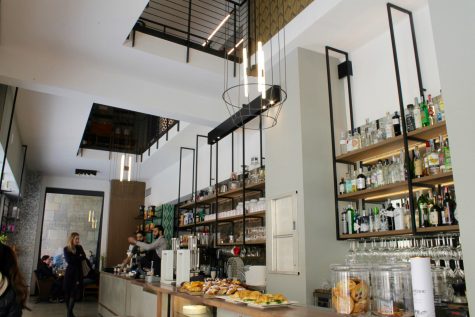
After 12 years of exciting and eye-opening travels around the world with visits to Honduras, Columbia, Costa Rica, Australia, as well as many locations in the United States, including New York, Seattle and San Francisco, Sanapo began to notice the different coffee cultures.
“When I was in Melbourne, I learned the café was not only about coffee, but a place where you can eat something really special, a place where the people have the opportunity to break and socialize. It is about the soul,” said Sanapo. He took these observations and opened up his first Ditta Artigianale coffee shop in Florence. This is where his coffee awakening began.
“We have an Italian soul, but international views,” Sanapo said.
After much success, the café has relocated from its first location on Via dei Neri to a new space that occupies a 1950’s structure in Oltrarno, the opposite side of the Arno River; famous Florentine architect, Giovanni Michelucci, constructed this building. Michelucci’s architecture served a functional purpose because it created a space for accomplishing lifestyle needs. His style is remembered as both rationalist and liberal, as seen in Florence’s Santa Maria Novella Train Station and the Cathedral of St. John the Baptist.
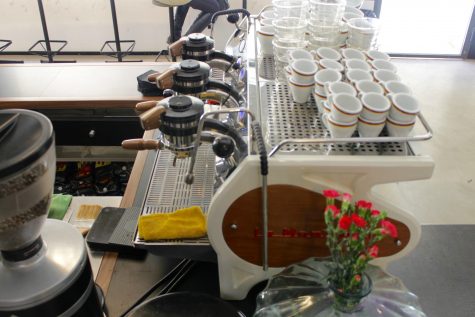
When Sanapo discovered that Michelucci had constructed the now-present Ditta Artigianale space, he worked to respect the architect’s style and way of thinking. At the time of the building’s construction, it was very common to build structures based off past models. Lorenzo Ghiberti’s Gates of Paradise on the Baptistery of San Giovanni, for example, drew inspiration from an ancient biblical scene of Abraham’s sacrifice, as well as modern Gothic style. And like the masters of centuries past, Sanapo has merged the old and new together seamlessly.
The first floor interior combines white, grey and light brown wood walls with spontaneous crevices of patterned colors. Walking up the steps across from the barista bar — complete with an espresso machine, tiny white cappuccino cups, and numerous coffee bean filters — your eyes will first be drawn to the turquoise corner wall, and then to its muted, yellow geometric pattern. This retro feeling compliments burgundy tabletops, which are edged in gold lining, and plush red and navy cinema chairs.
“I found most of these pieces from outdoor market sales and brought them here,” explained Sanapo.
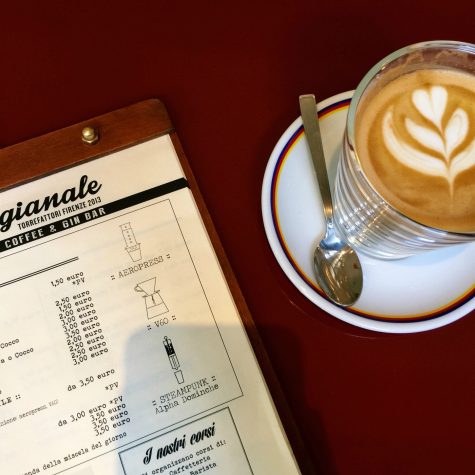
A spiral staircase swirls behind the bar, leading up to the second floor restaurant area. Its thin black railing blends with the subtle, modern lighting hanging from the top floor, which is also gated with the same iron material. The cohesive and fresh space is accompanied by jazzy tunes, Italian conversation and the tale behind each cup of crafted coffee.
“I made my shop like your house. You have to feel comfortable like at home,” said Sanapo.
Whether a customer orders a typical Italian espresso, or an international-style cold brew, there is a story behind each selection worth sharing; storytelling is the heart of this coffee revolution.
“We spend a lot of energy and power describing the flavor of the coffee. It is the most important part when we are in front of the customer,” said Sanapo.
The coffee’s producer, origins and process are also explained to each customer in a three-step process. First, the barista questions the customer about his/her experience with their chosen cup of coffee.
“We want to make him/her think about what they’re drinking,” Sanapo said.
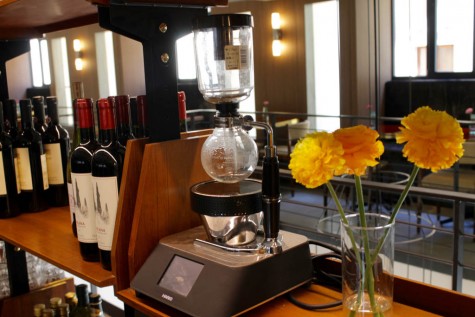
Secondly, the barista will offer the coffee without sugar to allow the customer to fully engage in the raw and unique flavor. Afterward, the customer is guided through a taste session. The coffee taster is asked to swirl his/her cup like a glass of wine and then smell the aroma. Next, they are encouraged to take the first sip while the barista describes the coffee’s origin.
“When a coffee is fresh roasted, this is different than a medium roast coffee. The first sip is the most intense in acidity and the impact is very different, so this is why we take it step by step,” said Sanapo. During the second sip, the acidity decreases and the full sweetness is revealed. “Whether it is almond or chocolate flavor, you will have more balance in your palate.”
At this stage, the levels of acidity and sweetness are accepted together. The third and final step allows the customer to fully enjoy the coffee.
“When you drink a good coffee, your mouth will stimulate, and this is the experience we share with our customers,” Sanapo said.
Freshly-brewed coffee isn’t the only aroma or taste you can experience at Ditta Artigianale. Here, you’ll often hear the ringing of a small silver bell. This alerts the staff — dressed uniformly in dark denim aprons complete with the Ditta Artigianale name stitched in a red, blue and yellow rectangle — that a customer’s meal is ready.
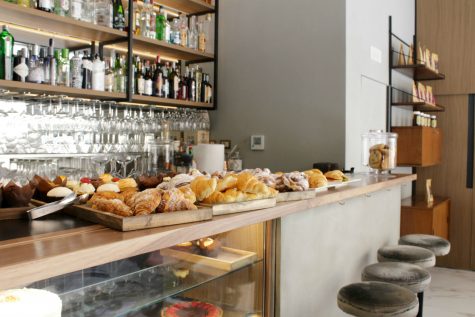
Ditta’s menu, offered in both Italian and English, includes a diverse selection of tea, beer, wine, soft drinks, cocktails, brunch, lunch, dinner and dessert. Many customers enjoy the avocado toast, or croque-madame, a sandwich made with toast, ham, cheese and egg.
When you visit, pick your choice of coffee and food, appreciate your cup’s story and plan to stay awhile. There’s something for everyone at Ditta, where Sanapo has brought specialty coffee to Italy and hopes to expose each customer to coffee culture.
“I dream of a coffee Renaissance,” he said.
Email Julie at [email protected] or follow her on Twitter @julie_sham.
